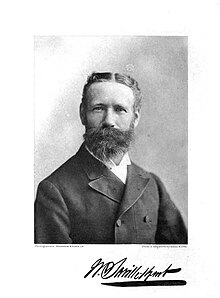William Saville-Kent
| William Saville-Kent | |
|---|---|

William Saville-Kent
|
|
| Born |
July 10, 1845 Bournemouth, Dorset |
| Died | October 11, 1908 (aged 63) Bournemouth, Dorset |
| Nationality | English |
| Fields | Marine Biology |
| Institutions | Royal Society of Queensland |
| Alma mater |
King's College London Royal School of Mines |
| Doctoral advisor | Thomas Henry Huxley |
| Known for | Study of coral reefs, oysters |
William Saville-Kent (10 July 1845, Sidmouth, Devon – 11 October 1908, Bournemouth, Dorset) was an English marine biologist.
Born in Sidmouth, Saville-Kent's childhood was marred by several unfortunate events: the death of his mother, the murder of his half-brother, and the subsequent conviction of his sister, Constance. The detective responsible for the investigation of his half-brother's murder also suspected that William was an accomplice, but no charges were ever made. Constance was sentenced to life in prison but served only twenty years.
Saville-Kent was educated at King's College London and then at the Royal School of Mines under T. H. Huxley. He held various jobs in Britain, including at the British Museum from 1866 to 1872. In 1869, he became a member of the Zoological Society of London and in 1873 of the Linnean Society. In 1870, Saville-Kent received a grant from the Royal Society to conduct a dredging survey off Portugal. He worked at the Brighton Aquarium (1872–1873), then at the Manchester Aquarium (1873–1876). He went on to work for various other aquariums, before returning to Brighton in 1879.
Saville-Kent married in 1872 but his wife died three years later. He remarried in 1876.
On the recommendation of Huxley, in 1884 Saville-Kent became Inspector of Fisheries in Tasmania. In 1889, he became Commissioner of Fisheries for Queensland, and in 1892, Commissioner of Fisheries for Western Australia, a position he held until 1895. During this time he experimented with culturing pearls on Thursday Island; his experiments were successful, and modern-day spherical cultured pearls are primarily the result of discoveries he made. These discoveries were later patented by Dr. Tokichi Nishikawa of Japan, who had heard of Saville-Kent's techniques. Later, Saville-Kent went on to chair the Royal Society of Queensland from 1889–1890.
...
Wikipedia
